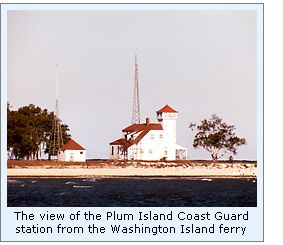|
The beginning
It was a seasonal station that operated from approximately mid April or whenever the ice would go out, to mid December where we did both lighthouse duty and search and rescue operations. The station was essentially two stations combined into one as history reveals. Our assigned area was from Cana Island Light on the west shore of Lake Michigan above Sturgeon Bay to a point ½ way across the lake, then north to a point including Poverty Island but not Summer Island, southwest west to a point half way across Green Bay and then due east to Fish Creek. Little did I realize at the time that Plum Island would not always exist as an operating station nor did I appreciate the lasting memories I would have of my brief "relationship" with that island. My first recollections of Plum Island was aboard the local ferry that made scheduled daily runs from the tip of Door County, Wisconsin to Washington Island. This particular day, it was to make an unscheduled stop at Plum for me and another Coastie by the name of Palmer, a third class electrician's mate. The twelve men that were assigned to seasonal duty at Plum came from various Coast Guard stations that made up the Group Two Rivers. As the early spring opening date approached, we all hop-scotched our way north to Sturgeon Bay Coast Guard Station over a period of about a week until we were finally settled on the island. The time of the year was late April - around the 17th or 18th as I recall. I could see the rear range light clearly that morning across the Ports De Morts Passage nearly a half mile away as I boarded Richter's oldest ferry, the Voyager. The old passenger ferry had a forward wheelhouse with a passenger salon large enough to carry about fifteen people just aft of that. It was unheated as I remember and had dark plywood paneling and a linoleum tiled deck. I traveled in my work dungarees, which was unusual for military travel but no one wore dress blues to the island. The island was heavily wooded to the gravel beach with occasional out crops of rock. I never noticed the tiny watch shack just west of the rear range lighthouse that was to be my refuge for literally hundreds of hours to come. The ferry took an unusual path that day around the island to the east which was opposite of its scheduled route to the west because the ice was still tight on the Green Bay side. Plum Island was off to our port as some one made mention of Pilot Island far off to starboard. It appeared much farther away than its approximate mile because it was so small. As I look at the pictures now thirty-six years later, the island is more barren than then. There were a couple pine trees to the north of the station and clumps of deciduous tree that grew beyond them at a height lower than the light. I would never get to Pilot Island until four years later after I had been reassigned aboard a 110 foot cutter out of Milwaukee to service the light. Even then, I had to remain on board and view her from a quarter of a mile away while the AtoN (Aids to Navigation) team took the small boat ashore and replaced the batteries that operated the automated light. Pilot Island was not manned in 1965 and had not been for several years before I got there.
Within a few moments, we were at the station dock where we were greeted by an older first class boatswains mate who's name I cannot remember but he was from Chicoteague, North Carolina and one of the finest seaman I was to ever know. He spoke with a strong Carolina accent - the kind that always commanded your attention. Along side of him was an BM3 named Theile, a good-natured blonde, blue eyed chap from Algoma, Wisconsin that has a lighthouse and Coast Guard Station of its own. I noticed his typical Green Bay accent when he mentioned his hometown. He pronounced it, "Algooooma". He always wore a smile. |
 Fresh out of the Coast Guard's boot
camp at Cape May, New Jersey in the fall of 1964, I had a short stay at
Group Two Rivers in the shore of Lake Michigan above Manitowoc that led
me to my first assignment at the Plum Island Coast Guard Station.
Fresh out of the Coast Guard's boot
camp at Cape May, New Jersey in the fall of 1964, I had a short stay at
Group Two Rivers in the shore of Lake Michigan above Manitowoc that led
me to my first assignment at the Plum Island Coast Guard Station. As the ferry plodded northward around
the West Side of Plum Island, the large white boathouse with its dark
red roof revealed itself and then the lifeboat station itself. It
appeared then much as it does today only brilliant white from its
always-recent paint job. It pains me today to see the gray bare cedar
shingles where the paint has been allowed to wear away on the tower from
neglect. Coast Guard stations were always meticulously clean and well
maintained. This wooden station is built incredibly well and could stand
another 100 years without extraordinary maintenance.
As the ferry plodded northward around
the West Side of Plum Island, the large white boathouse with its dark
red roof revealed itself and then the lifeboat station itself. It
appeared then much as it does today only brilliant white from its
always-recent paint job. It pains me today to see the gray bare cedar
shingles where the paint has been allowed to wear away on the tower from
neglect. Coast Guard stations were always meticulously clean and well
maintained. This wooden station is built incredibly well and could stand
another 100 years without extraordinary maintenance.